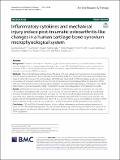Inflammatory cytokines and mechanical injury induce post-traumatic osteoarthritis-like changes in a human cartilage-bone-synovium microphysiological system
Author(s)
Dwivedi, Garima; Flaman, Lisa; Alaybeyoglu, Begum; Struglics, André; Frank, Eliot H.; Chubinskya, Susan; Trippel, Stephen B.; Rosen, Vicki; Cirit, Murat; Grodzinsky, Alan J.; ... Show more Show less
Download13075_2022_Article_2881.pdf (3.745Mb)
Publisher with Creative Commons License
Publisher with Creative Commons License
Creative Commons Attribution
Terms of use
Metadata
Show full item recordAbstract
Abstract
Background
Traumatic knee injuries in humans trigger an immediate increase in synovial fluid levels of inflammatory cytokines that accompany impact damage to joint tissues. We developed a human in vitro cartilage-bone-synovium (CBS) coculture model to study the role of mechanical injury and inflammation in the initiation of post-traumatic osteoarthritis (PTOA)-like disease.
Methods
Osteochondral plugs (cartilage-bone, CB) along with joint capsule synovium explants (S) were harvested from 25 cadaveric distal femurs from 16 human donors (Collin’s grade 0–2, 23–83years). Two-week monocultures (cartilage (C), bone (B), synovium (S)) and cocultures (CB, CBS) were established. A PTOA-like disease group was initiated via coculture of synovium explants with mechanically impacted osteochondral plugs (CBS+INJ, peak stress 5MPa) with non-impacted CB as controls. Disease-like progression was assessed through analyses of changes in cell viability, inflammatory cytokines released to media (10-plex ELISA), tissue matrix degradation, and metabolomics profile.
Results
Immediate increases in concentrations of a panel of inflammatory cytokines occurred in CBS+INJ and CBS cocultures and cultures with S alone (IL-1, IL-6, IL-8, and TNF-α among others). CBS+INJ and CBS also showed increased chondrocyte death compared to uninjured CB. The release of sulfated glycosaminoglycans (sGAG) and associated ARGS-aggrecan neoepitope fragments to the medium was significantly increased in CBS and CBS+INJ groups. Distinct metabolomics profiles were observed for C, B, and S monocultures, and metabolites related to inflammatory response in CBS versus CB (e.g., kynurenine, 1-methylnicotinamide, and hypoxanthine) were identified.
Conclusion
CBS and CBS+INJ models showed distinct cellular, inflammatory, and matrix-related alterations relevant to PTOA-like initiation/progression. The use of human knee tissues from donors that had no prior history of OA disease suggests the relevance of this model in highlighting the role of injury and inflammation in earliest stages of PTOA progression.
Date issued
2022-08-18Department
Massachusetts Institute of Technology. Department of Biological Engineering; Massachusetts Institute of Technology. Department of Electrical Engineering and Computer Science; Massachusetts Institute of Technology. Department of Mechanical EngineeringPublisher
BioMed Central
Citation
Arthritis Research & Therapy. 2022 Aug 18;24(1):198
Version: Final published version